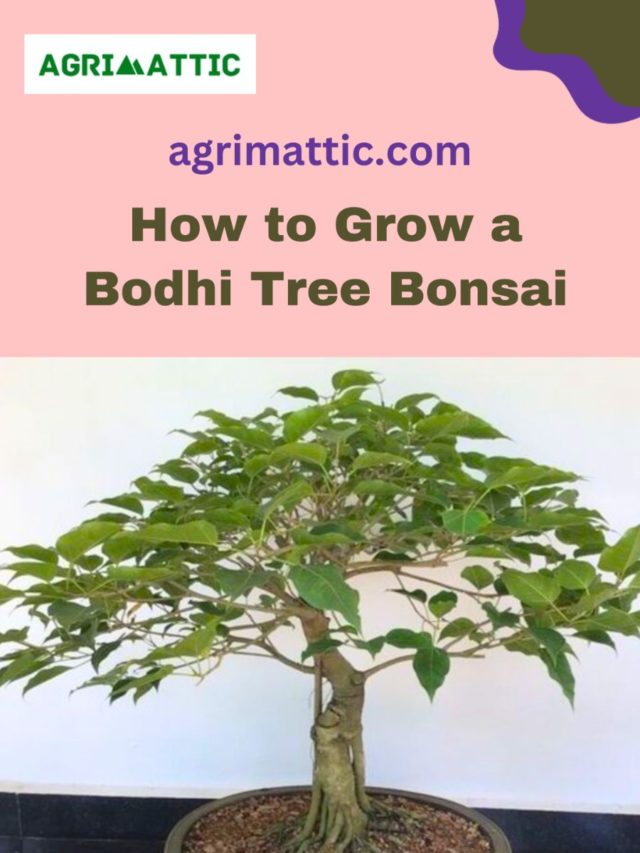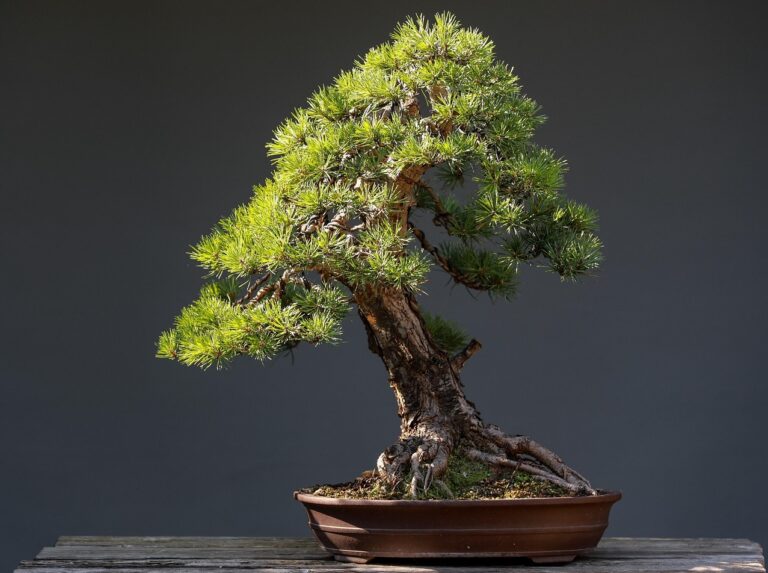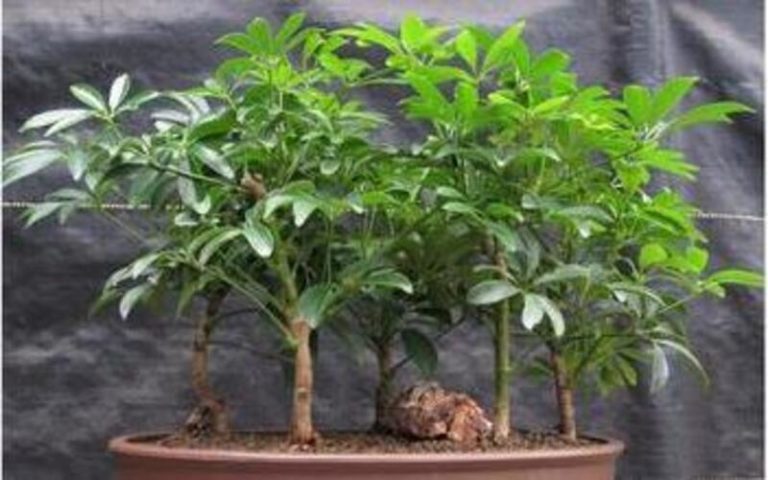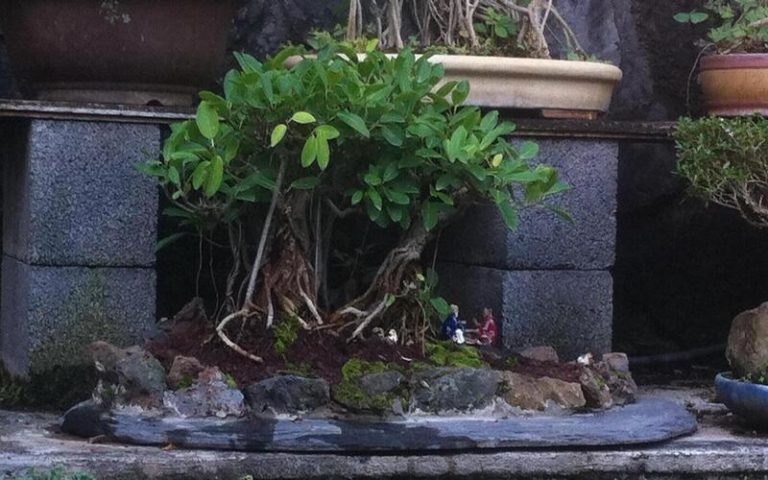Bodhi Tree Bonsai: A Beautiful Art of Cultivating Peace
Bonsai is an ancient and cherished art form that involves growing miniature trees in containers. One of the most revered trees in this art is the Bodhi tree bonsai. In this article, we will explore the Bodhi tree bonsai, its cultural significance, and how you can care for and style this exquisite tree.
What is a Bodhi Tree Bonsai?
A Bodhi tree bonsai is a small version of the Bodhi tree, which is where Gautama Buddha found wisdom. It is grown using the art of bonsai, in which trees are made carefully and grown in small pots. The Bodhi tree bonsai stands for knowledge, mental growth, and enlightenment. To take care of it, you need to give it the right climate, prune, shape, and sometimes repot it. It is an artistic representation of the full-size Bodhi tree and a sign of calmness and inner peace.
History and Origins of the Bodhi tree bonsai
The background and roots of the Bodhi tree bonsai go back to the cultural and spiritual importance of the Bodhi tree itself. In Buddhism, the Bodhi tree, also called Ficus religiosa, is very important because it is the tree under which Gautama Buddha became enlightened.
The story takes place in Bodh Gaya, India, over 2,500 years ago. Siddhartha Gautama, who would later be known as Buddha, tried to find wisdom by sitting in deep meditation under a Bodhi tree. After a long time of deep thought, he reached enlightenment and became the Buddha, which means “the one who has awakened.”
After this life-changing event, people began to respect the Bodhi tree even more. It became a holy sign and place of travel for Buddhists all over the world. Over time, the Bodhi tree became an important part of the art of bonsai, which came from China, Japan, and other Asian countries.
Growing Bodhi tree bonsai started as a way to catch the spirit and meaning of this important tree in a smaller, easier-to-care-for form. By carefully growing and shaping the small Bodhi tree, fans tried to make it look and feel as beautiful and peaceful as the full-size tree.
The art of bonsai and growing Bodhi tree bonsai spread to different parts of the world, where they became famous among bonsai fans and people who wanted to learn more about Buddhist teachings and customs. Today, the Bodhi tree bonsai is still admired as a symbol of knowledge, enlightenment, and spiritual growth. It has the same long past and deep meaning as the Bodhi tree itself.
Bodhi tree bonsai and Their Symbolism
Bodhi tree bonsai carries deep symbolism derived from the significance of the Bodhi tree itself. Here are some key aspects of symbolism associated with Bodhi tree bonsai:
1. Enlightenment and Wisdom: Gautama Buddha’s wisdom is closely linked to the Bodhi tree. So, the Bodhi tree bonsai represents the search for knowledge, mental growth, and waking up to reality. It’s a warning that everyone has the ability to become wise.
2. Inner Peace and Tranquility: The Bodhi tree bonsai shows an inner sense of peace and calm. Gautama Buddha meditated under the full-size Bodhi tree, which gave him shade and peace. The small version of the tree has the same spirit. It’s a visual message to try to find peace inside, even when life is crazy.
3. Connection to Nature and the Natural World: Bonsai in general, including the Bodhi tree bonsai, symbolizes the harmony between humans and nature. The careful cultivation and shaping of the bonsai reflect the delicate balance and interdependence between the natural world and our existence. It encourages us to appreciate and respect the beauty and wisdom found in nature.
4. Timelessness and Endurance: The Bodhi tree is thought to be hundreds of years old, and bonsai art stresses how long trees live and how strong they are. The Bodhi tree bonsai represents the passing of time, the cycles of life, and the fact that knowledge and faith last for generations.
5. Cultural and Spiritual Heritage: The Bodhi tree bonsai carries cultural and spiritual heritage associated with Buddhism. It represents the teachings, traditions, and values espoused by Gautama Buddha. Displaying and nurturing a Bodhi tree bonsai is a way to connect with this rich heritage and pay homage to the wisdom and enlightenment embodied by the Bodhi tree.
The symbolism of the Bodhi tree bonsai extends beyond its physical appearance, reflecting deeper philosophical and spiritual concepts. It serves as a gentle reminder to seek personal growth, cultivate inner peace, and embrace the wisdom inherent in nature and ourselves.
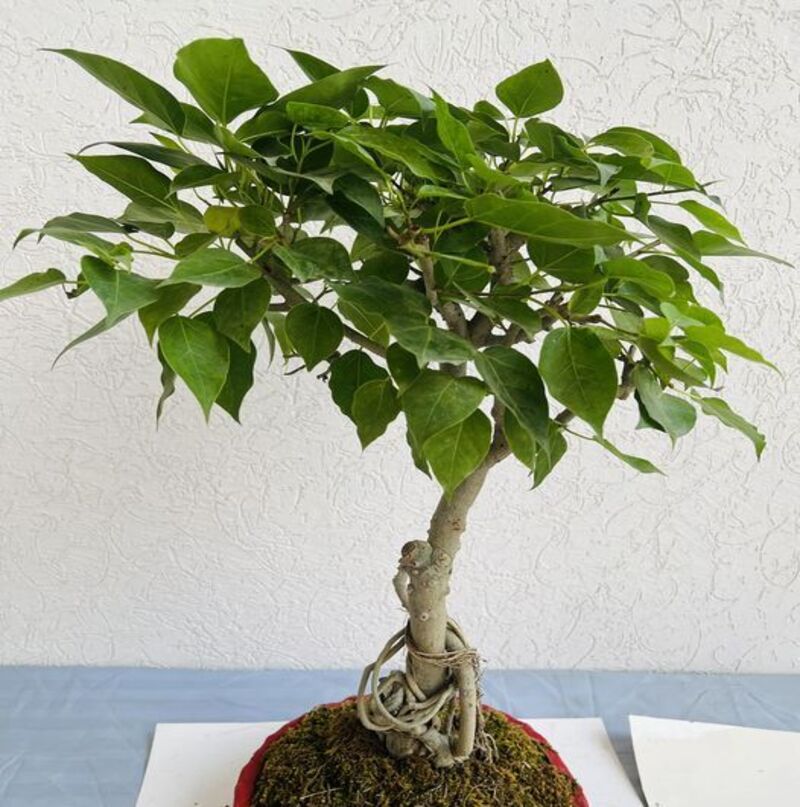
Characteristics of the Bodhi Tree Bonsai
The Bodhi tree bonsai possesses several distinct characteristics that make it unique and captivating. Here are some notable features of the Bodhi tree bonsai:
- Leaf Structure: The small, heart-shaped leaves of the Bodhi tree bonsai look like the leaves of a full-sized Bodhi tree. The leaves are close together and thick, making a lush and colorful cover.
- Trunk and Bark: The stem of the Bodhi tree bonsai has designs that are both interesting and complicated. It often gets rough and twisted looking, showing how old and strong the tree is. Depending on how old the tree is, the bark may be smooth or a little rough.
- Root System: The roots of the Bodhi tree bonsai are well-known and visible, which adds to its visual appeal. The roots can be trained and placed with care to improve the bonsai’s general balance and artistic expression.
- Miniature Size: As a bonsai, the Bodhi tree is kept small and close to the ground. The bonsai artist carefully prunes and forms the tree so that it stays small but still has the same feel as a full-sized Bodhi tree. This smaller size makes it good for displaying indoors and adds to its charm.
- Symbolic Form: The Bodhi tree bonsai is often made in traditional bonsai ways, such as formal straight, slanting, or cascade. These shapes bring out the symbolism of the tree and give a feeling of unity, balance, and beauty.
- Spiritual Significance: The Bodhi tree bonsai has deep spiritual and cultural meanings. It is a symbol of awakening, knowledge, and inner peace. Its appearance is a sign that you can grow as a person and try to find spiritual awakening.
- Longevity: With proper care, the Bodhi tree bonsai can live for many years, mirroring the longevity of the full-sized Bodhi tree. This allows bonsai enthusiasts to develop a deep connection with their tree over an extended period.
The things about the Bodhi tree bonsai that make it appealing as a form of live art. Its intricate leaves, expressive trunk, and deep meaning make it a fascinating addition to any bonsai collection or indoor space, welcoming thought and promoting a feeling of calm.
Types of Bodhi Tree Bonsai
There are different types of Bodhi tree bonsai that fans can grow and enjoy. Even though the species is Ficus religiosa, there are differences in leaf size, color, and growing habits. Here are a few famous types of Bodhi tree bonsais:
Regular Leaf Bodhi Tree Bonsai: This type of Bodhi tree bonsai features regular-sized leaves, similar to those found on the full-sized Bodhi tree. The leaves are typically heart-shaped and contribute to the bonsai’s lush and dense foliage.
Dwarf Leaf Bodhi Tree Bonsai: This type of Bodhi tree bonsai, as the name suggests, has smaller leaves than the other types. The dwarf leaves make the tree’s crown more delicate and complex, which draws attention to how small the tree is.
Variegated Leaf Bodhi Tree Bonsai: Changeable leaf The leaves of a Bodhi tree bonsai have designs of different colors, like green and white or green and yellow. The different colors give the bonsai’s leaves more visual interest and make them stand out.
Weeping Bodhi Tree Bonsai: This type of Bodhi tree bonsai has branches that hang down or “weep.” The branches gently curve down, giving the tree a beautiful, flowing shape. The falling Bodhi tree bonsai looks especially beautiful on a bonsai stand that looks like a waterfall.
Banyan-style Bodhi Tree Bonsai: This type of Bodhi tree bonsai was inspired by the way banyan trees grow. It has aerial roots that grow down from the branches and turn into secondary trunks. The banyan-style bonsai has a network of tangled roots that make a beautiful and complex display.
These are just some of the different kinds of Bodhi tree bonsai that fans can grow. Each type has its own look and special qualities that let bonsai artists show their creativity and personal tastes. No matter which style of Bodhi tree bonsai you choose—regular leaf, dwarf leaf, multicolored leaf, weeping, or banyan—the tree’s meaning and beauty will shine through.
How to Grow a Bodhi Tree Bonsai
Growing a Bodhi tree bonsai demands attention to detail and right procedures. Here’s a step-by-step instruction to growing a Bodhi tree bonsai:
- Obtaining a Bodhi Tree Bonsai: Begin by purchasing a young Bodhi tree seedling or pre-bonsai specimen from a reliable nursery or bonsai provider. Make sure the sapling has a strong root system and a well-formed trunk.
- Choosing the Right Container: Choose a bonsai container that has adequate drainage holes. The container should be appropriate to the size of the tree and leave area for the roots to grow.
- Preparing the Soil: Use a well-draining bonsai soil mix that has both organic and inorganic components. This will enable appropriate water retention while also ensuring proper drainage to prevent soggy roots.
- Repotting the Bonsai: If your bonsai Bodhi tree is in a seedling pot, carefully take it out and cut any roots that are too long or twisted. Place the bonsai in the container you picked, spreading out the roots and making sure they touch the dirt. Don’t bury the trunk too far down.
- Providing Adequate Light: Place the Bodhi tree bonsai in a location with bright, indirect sunlight. Bodhi trees thrive in well-lit areas but should be protected from intense, direct sunlight that can scorch the leaves.
- Watering: Use the right amount of water to keep the dirt fairly moist, but not too wet. Put your finger into the dirt to check how wet it is. If your first finger feels dry, it’s time to water. Change the frequency based on the tree’s needs and how the surroundings is.
- Fertilizing: Feed your Bodhi tree bonsai a balanced, water-soluble bonsai fertilizer during the growing season. Follow the manufacturer’s guidelines for how much to use and how often. This will give you the nutrients you need for good growth.
- Pruning and Shaping: Regularly cut back the branches and leaves to keep the bonsai in the shape and size you want. Use sharp bonsai trimming tools to make clean cuts and get rid of any dead, damaged, or unwanted growth.
- Wiring and Training: Use bonsai wire to form and train the branches into the position you want. Don’t put too much pressure on the wire as you wrap it around the trees because that could cause damage. Adjust the wire every so often to help the buds grow in the right direction.
- Protection from Pests and Diseases: Monitor your Bodhi tree bonsai for any signs of pests or diseases, such as aphids, scale insects, or fungal infections. Take prompt action if you notice any issues, using appropriate organic or chemical treatments as necessary.
- Patience and Maintenance: A Bodhi tree bonsai takes a long time to grow. Be flexible and stick to your plan for care, making changes as needed. Every two to three years, you should repot the bonsai to refresh the dirt and encourage healthy root growth.
Remember that each Bodhi tree bonsai is different, and it may take time and a few tries to get the look and shape you want. Enjoy the process and appreciate the beauty of your growing Bodhi tree bonsai as it turns into a live work of art.
Benefits of the Bodhi Tree Bonsai
The Bodhi tree bonsai has more benefits than just looking nice. Here are some of the best reasons to grow a Bodhi tree bonsai and enjoy it:
Symbolic Significance: The Bodhi tree bonsai has a lot of symbolic meanings that have to do with spiritual growth, awareness, and knowledge. Its appearance serves as a visible reminder of these deep ideas and can encourage you to think about yourself and grow.
Connection to Nature: By taking care of a Bodhi tree bonsai, you can get in touch with nature on a smaller scale. It lets you see and enjoy the intricate growth patterns, leaves, and root system of a living tree. This helps you value the beauty and strength of nature more.
Mindfulness and Stress Reduction: Working with a Bodhi tree bonsai can help to foster mindfulness and tranquillity. Observing and caring for the bonsai’s growth can help relieve stress, boost attention, and generate a relaxing impact. It provides a contemplative experience that helps you to be in the moment and discover peace in nature.
Indoor Decor and Serene Environment: The bonsai Bodhi tree is a wonderful complement to any interior area. Because of its tiny size, it is ideal for displaying on tabletops, desks, or shelves, adding a sense of nature and peace to your surroundings. The presence of a bonsai may improve the mood of a space, producing a quiet and pleasant setting.
Therapeutic and Educational Value: Growing a Bodhi tree bonsai and taking care of it can be both relaxing and informative. It’s a chance to learn about the art of bonsai, gardening, and the needs of the Bodhi tree in particular. Bonsai can be shaped and trained in a way that is both artistic and mentally satisfying.
Longevity and Legacy: With proper care, a Bodhi tree bonsai can live for many years, becoming a cherished part of your life and potentially even passed down through generations. The longevity of the bonsai allows for a lasting connection and a sense of legacy, as you nurture and shape a living piece of art.
Conversation Starter and Cultural Appreciation:The bonsai of the Bodhi tree can start talks about Buddhism, mental growth, and the art of bonsai. It is a physical reminder of cultural history and can help people learn more about and appreciate these customs.
Overall, the Bodhi tree bonsai offers not only visual delight but also opportunities for personal growth, relaxation, and a deeper connection to nature and spirituality. Its presence can positively impact your well-being and create a serene atmosphere in your living or working space.
Showcasing Your Bodhi Tree Bonsai
Putting your Bodhi tree bonsai on display is a great way to show off its beauty and explain what it means to others. Here are some ideas for putting your Bodhi tree bonsai on display:
Bonsai Stand: Buy a bonsai stand that goes well with the style and look of your Bodhi tree bonsai. The stand raises the bonsai, giving it a sense of grace and making it the center of attention. Choose a wooden, stone, or metal stand that fits in with the rest of the show.
Indoor Display: Your Bodhi tree bonsai should be kept in a well-lit room indoors, like a living room, office, or meditation room. Use a bonsai display table or shelf made especially for showing off bonsai. Make sure the spot gets enough indirect sunlight and doesn’t have extreme temperature changes or drafts.
Outdoor Display: If weather conditions permit, you can showcase your Bodhi tree bonsai outdoors. A patio, balcony, or garden area can serve as a beautiful backdrop. Position the bonsai on a sturdy stand or a flat surface where it can be admired by visitors and passersby.
Curated Bonsai Display: Create a display area for your Bodhi tree bonsai and other bonsai. Arrange them in a pleasing manner, taking into mind their sizes, shapes, and colors. Consider putting rocks, moss, or miniature figurines as accents to improve the overall appearance.
Seasonal Themes: Incorporate seasonal components into your Bodhi tree bonsai display to celebrate the changing seasons. For example, in the spring, you may complement the bonsai with miniature cherry blossoms. In the winter, you may add little Christmas ornaments or snow-like materials to create a festive atmosphere.
Bonsai Exhibition or Club: Participate in bonsai exhibits in your area or join a bonsai club or community. These sites allow you to display your Bodhi tree bonsai alongside the work of other bonsai lovers. It allows you to express your enthusiasm, receive criticism, and learn from other fans.
Social Media and Photography: Take pictures of your Bodhi tree bonsai to show off its beauty and share them on social media sites or groups just for bonsai. It lets you connect with a bigger audience, get comments, and talk about how to grow bonsai and how it should look.
Remember to maintain and care for your Bodhi tree bonsai on a regular basis to keep it healthy and alive. Pruning, watering, and fertilizing it properly will help it preserve its attractiveness and highlight its greatest attributes. By displaying your Bodhi tree bonsai, you may inspire people with its meaning while also creating an aesthetically appealing exhibit for all to enjoy.
Styling and Design of a Bodhi Tree Bonsai
A Bodhi tree bonsai is styled and designed with careful trimming, wiring, and shape to make a pleasing and harmonious arrangement. Here are some important things to think about when creating and making a Bodhi tree bonsai:
1. Selecting a Style: Choose a type of bonsai that fits your ideas and the way your Bodhi tree grows. Bonsai styles include formal upright, informal upright, slanting, waterfall, and windswept. Each style has a different look and shows a different natural shape or way of growing.
2. Trunk Formation: Think about the width, curve, and movement of the trunk you want. The base should get thinner as it goes up, and it can have small curves or turns to make it look more interesting. Take off any stems or growth that aren’t needed or that take away from the shape of the trunk you want.
3. Branch Placement: Set up the branches so that they look like the way the Bodhi tree grows naturally. Place the branches at different heights and angles to create a feeling of symmetry and proportion. Don’t crowd the tree, and make sure there is enough room between the leaves to let light and air flow.
4. Pruning and Pinching: To keep the Bodhi tree bonsai in the shape and size you want, you must prune it regularly. Use sharp bonsai pruning tools to cut away useless branches, dead wood, and extra growth. You can also pinch or prune the leaves to encourage growth of smaller leaves and keep the plant’s shape.
5. Wiring and Shaping: Wiring is a way to get the stems to grow where you want them to. Wrap metal or copper wire around twigs to give them a gentle shape. Be careful not to put too much pressure on the bark, which can hurt or scar it. Adjust the wire every so often to make room for growth.
6. Apex and Canopy Formation: The top, or tip, of the Bodhi tree bonsai should be carefully made to make a crown that looks whole and balanced. Think about how tall and full you want the tree’s canopy to be and make sure it fits with the tree’s base and general shape. You can get the look you want by trimming and wiring.
7. Root Placement: Pay close attention to where and how the uncovered roots of the Bodhi tree bonsai are placed. Roots that are visible can be placed in a way that makes the whole thing look better. They should look like they belong and match the tree’s shape. When you need to, use root trimming methods to keep a healthy root system.
8. Patience and Refinement: The design and styling of a Bodhi tree bonsai is an ongoing process that takes time, patience, and polish. Check on the bonsai’s growth and structure often and make changes as needed. The tree will continue to grow and change, which will let its form be tweaked and improved.
Remember that the way you style and make a Bodhi tree bonsai should show your own artistic style and show respect for the way the tree grows naturally. You can arrange your Bodhi tree bonsai in a way that is pleasing to the eye and shows off its unique beauty if you think about it and are good at it.

How to Care for and Maintain a Bodhi Tree Bonsai
A Bodhi tree bonsai’s health and lifespan are dependent on proper care and upkeep. Here are some crucial rules to remember:
- Watering: Provide consistent and appropriate watering to keep the soil evenly moist. Avoid overwatering, as it can lead to root rot, and underwatering, which can cause stress to the tree. Water the bonsai thoroughly until the water drains out of the drainage holes, and allow the topsoil to slightly dry out between watering.
- Light and Temperature: The Bodhi tree bonsai should be put in a spot that gets both direct and partial sunshine. It does best in warm, wet places, especially between 65 and 85 degrees Fahrenheit (18 and 29 degrees Celsius). Stay away from extreme heat, wind, and direct sunlight, which can burn the leaves.
- Humidity: Bodhi tree bonsai appreciates a humid environment. You can increase humidity by placing the bonsai on a humidity tray filled with water and pebbles or by misting the leaves regularly. Avoid misting excessively during cooler temperatures to prevent chilling.
- Fertilizing: Apply a balanced, water-soluble bonsai fertilizer during the growing season, typically from spring to early autumn. Follow the manufacturer’s instructions for dosage and frequency. Reduce or stop fertilization during the dormant winter period.
- Pruning and Trimming: Regularly prune and trim the Bodhi tree bonsai to maintain its shape, remove dead or overgrown branches, and promote branching. Use sharp bonsai pruning shears to make clean cuts. Pruning is best done during the active growing season.
- Wiring and Training: Use bonsai wire to shape and guide the branches into the desired position. Be careful not to wire too tightly, as it can cause damage. Regularly check the wire to ensure it does not cut into the bark as the branches thicken. Remove the wire after a few months to prevent wire scars.
- Soil and Repotting: Use a well-draining bonsai soil mix that provides good aeration and water retention. Repot the Bodhi tree bonsai every 1-2 years, typically in spring before new growth emerges. Prune the roots and replace a portion of the soil to maintain the health of the root system.
- Pest and Disease Control: Regularly inspect the bonsai for pests like aphids, scale insects, or spider mites. Treat infestations promptly using appropriate organic or chemical methods. Ensure good airflow around the bonsai to prevent fungal diseases. Remove any diseased or damaged foliage.
- Winter Care: Protect the Bodhi tree bonsai from freezing temperatures during winter. If kept outdoors, provide frost protection by placing the bonsai in a sheltered area or using insulation. If kept indoors, ensure it receives sufficient light and maintain proper humidity levels.
- Observation and Careful Monitoring: Observe your Bodhi tree bonsai regularly for any signs of stress, pests, or disease. Pay attention to changes in leaf color, growth patterns, or unusual symptoms. Address any issues promptly to prevent further damage.
By following these care guidelines, you can maintain the health and vitality of your Bodhi tree bonsai, allowing it to thrive and bring you joy for years to come. Remember that each bonsai is unique, and adjustments to care routines may be necessary based on individual circumstances and environmental conditions.
Bodhi Tree Bonsai Care Sheet
| Aspect | Care Tips |
| Watering | Water the bonsai thoroughly until water drains out of the drainage holes. Allow the topsoil to slightly dry out between watering. |
| Sunlight | Place the bonsai in a location with bright, indirect sunlight. Protect it from direct sunlight that can scorch the leaves. |
| Temperature | Keep the bonsai in a warm environment, ideally between 65-85°F (18-29°C). |
| Humidity | Increase humidity by using a humidity tray or misting the leaves regularly. Avoid excessive misting during cooler temperatures. |
| Fertilization | Apply a balanced, water-soluble bonsai fertilizer during the growing season. Follow the manufacturer’s instructions for dosage. |
| Pruning and Trimming | Regularly prune and trim to maintain shape and remove dead or overgrown branches. Prune during the active growing season. |
| Wiring and Styling | Use bonsai wire to shape and guide branches carefully. Avoid wiring too tightly or for extended periods to prevent damage. |
| Repotting | Repot the bonsai every 1-2 years in a well-draining bonsai soil mix. Prune the roots and replace a portion of the soil. |
| Pest and Disease Control | Regularly inspect for pests and treat infestations promptly using appropriate methods. Ensure good airflow to prevent diseases. |
| Winter Care | Protect the bonsai from freezing temperatures with shelter or insulation. Maintain proper light and humidity levels indoors. |
| Regular Maintenance | Regularly observe the bonsai for signs of stress, pests, or diseases. Address issues promptly to prevent further damage. |
Remember, each Bodhi tree bonsai may have specific care requirements based on its individual needs and environmental conditions. Use this care sheet as a general guide and adapt it as necessary to ensure the well-being and vitality of your Bodhi tree bonsai.
Conclusion
Cultivating a Bodhi tree bonsai is not only a rewarding experience but also a way to connect with nature and find inner peace. By understanding its cultural significance, caring for it diligently, and styling it with love, you can create a breathtaking bonsai that embodies the wisdom and enlightenment of the Bodhi tree. Embrace this ancient art form, and let the Bodhi tree bonsai bring harmony and serenity to your life.
FAQ
Q: What is Bodhi Tree Bonsai?
Bodhi Tree Bonsai is the cultivation and shaping of a bonsai tree from the Bodhi tree (Ficus religiosa), which holds deep significance in Buddhism as the tree where Gautama Buddha attained enlightenment. Bodhi Tree Bonsai symbolizes enlightenment, wisdom, and spiritual growth in a compact and meaningful way.
Q: What is the meaning and symbolism of Bodhi Tree Bonsai?
A: Bodhi Tree Bonsai symbolizes enlightenment, spiritual growth, and wisdom. It represents the tree under which Gautama Buddha attained enlightenment.
Q: Can I grow a Bodhi Tree Bonsai indoors?
A: Yes, Bodhi Tree Bonsai can be grown indoors. Just ensure it receives bright, indirect sunlight and proper care for its growth.
Q: How often should I water my Bodhi Tree Bonsai?
A: Watering frequency depends on factors like climate and pot size. Generally, water the bonsai thoroughly when the topsoil starts to slightly dry out.
Q: Do I need to fertilize my Bodhi Tree Bonsai?
A: Yes, regular fertilization is necessary for the healthy growth of Bodhi Tree Bonsai. Use a balanced, water-soluble bonsai fertilizer during the growing season.
Q: How often should I prune my Bodhi Tree Bonsai?
A: Pruning is typically done during the active growing season. Regularly prune to maintain the shape, remove dead branches, and encourage branching.
Q: Can I wire and shape the branches of my Bodhi Tree Bonsai?
A: Yes, wiring is a common technique to shape the branches of Bodhi Tree Bonsai. Use bonsai wire carefully and adjust it periodically as the branches grow.
Q: When should I repot my Bodhi Tree Bonsai?
A: Repotting is usually done every 1-2 years in spring before new growth emerges. Prune the roots and replace a portion of the soil during repotting.
Q: How do I protect my Bodhi Tree Bonsai during winter?
A: During winter, protect your Bodhi Tree Bonsai from freezing temperatures by providing shelter, insulation, or bringing it indoors if necessary.
Q: How do I prevent pests and diseases on my Bodhi Tree Bonsai?
A: Regularly inspect your bonsai for pests and diseases. Treat any infestations promptly using appropriate organic or chemical methods and ensure good airflow around the tree.
Q: Is it possible to propagate a Bodhi Tree Bonsai from cuttings?
A: Yes, it is possible to propagate Bodhi Tree Bonsai from cuttings. Take stem cuttings and follow proper propagation techniques to encourage root growth.
Also read:


